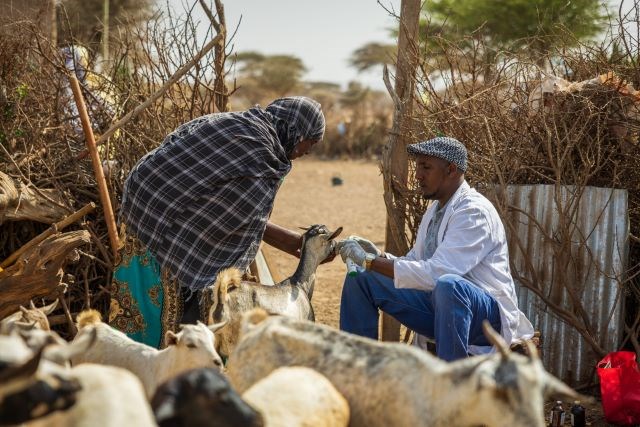
Saturday May 7, 2022

The Food and Agriculture Organization of the United Nations
(FAO), in partnership with government and other implementing partners, has
reached almost 11 million livestock belonging to around 275 000 rural families
with supportive emergency treatment services in Somalia. Funded by the United
States Agency for International Development and the Qatar Fund For Development,
the milestone comes at a time when the country faces a humanitarian emergency
due to extreme drought. Over 750 000 people have fled their homes in search of
assistance, and rural communities have been the hardest hit as water and
pasture dried up and livestock perished. Implemented through local government
partners, the campaign targeted drought-affected households, with the goal to
maintain productive assets that are critical for the food security and
nutrition of vulnerable families, especially those with young children.
As of February 2022, FAO’s Food Security Nutrition and
Analysis Unit (FSNAU) estimated that some rural households in the most drought
affected areas had lost up to 30 percent of their animals to drought. “We’ve
seen drought-related livestock disease in pastoral areas, and this directly
impacts their ability to cope with these climate shocks,” said FAO’s Livestock
Coordinator, Khalid Saeed. “We scaled up quickly through local government
partners to achieve this goal, with a sense of urgency that lives and
livelihoods were on the line,” he said. The treatments administered are
intended to protect livestock from common drought-related diseases that can be
lethal to an animal already weakened by drought.
Livestock a lifeline
for young children
Livestock are not just a financial commodity for rural
Somali families but are essential for human health. Young children rely on milk
and meat supply from the family’s herd for their nutrition and development.
Households that experience livestock death due to drought see a rapid decline
in food security and nutrition, endangering the health and nutrition of their
young children. “The nutrition and health of young Somali children are directly
linked to the health of their animals and the ecosystems they live in,” said
FAO Nutrition Officer, Emma Ouma. “Healthy livestock provide high biological
value proteins, vitamins and minerals from the milk and meat they produce.
Livestock are a lifeline for young children. Without these critical nutritional
benefits the negative impacts in their growth and development can last for
years,” she said.
In Somalia, around 1.4 million children are malnourished,
with around 330 000 children severely acutely malnourished, according to FSNAU.
For families that lose their livestock, their children risk acute malnutrition
or even worse outcomes if they don’t receive help soon enough.
As well as supporting animal health, FAO is bringing
emergency cash and livelihood assistance to rural areas, as closely as possible
to affected communities. This helps to keep families and communities together
during crisis, reducing psychosocial and physical risks to the vulnerable,
paving the way for a faster and more sustainable recovery.
FAO in Somalia urgently requires USD 131.4 million to
increase immediate food access in rural areas, safeguarding livelihoods, and
support seasonal food production, and to provide supporting evidence and
coordination of drought response actions. “The risk of famine is growing every
day, but with an urgent injection of humanitarian funding from the
international community there is still time to avert a catastrophe,” said
Etienne Peterschmitt, FAO’s Representative in Somalia. FAO aims to assist 882
000 people across 52 districts targeting the worst drought-affected rural
communities.